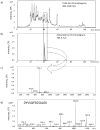Detection of metals and metalloproteins in the plasma of stroke patients by mass spectrometry methods
- PMID: 22983496
- PMCID: PMC4739645
- DOI: 10.1039/c2mt20092a
Detection of metals and metalloproteins in the plasma of stroke patients by mass spectrometry methods
Abstract
Stroke is the leading cause of adult disability, worldwide. Metalloproteins and metals play key roles in epigenetic events in living organisms, including hypertension, the most important modifiable risk factor for stroke. Thus, metalloproteins may be important target biomarkers for disease diagnosis. The primary goal of this study was to assess metal containing proteins in blood plasma, detected by ICP-MS, followed by ESIMS for peptide/protein identification. We then compared the relative concentration differences between samples from patients with ischemic stroke, hemorrhagic stroke and stroke mimics. In 29 plasma samples (10 stroke mimics, 10 ischemic stroke and 9 hemorrhagic stroke patients) previously collected from patients who presented to the University of Cincinnati Emergency Department within 12 hours of symptom onset for a plasma banking project. For the metal associated protein study, Mg, Mn, Cu, Se concentrations were statistically different when compared between stroke mimics vs. ischemic stroke patients and ischemic stroke patients vs. hemorrhagic stroke patients. Pb concentrations were statistically different when compared between stroke mimics vs. ischemic stroke patients and Mo levels were statistically the same among the three groups. In addition, we also report concentration levels and preliminary correlation studies for total elemental analysis among the three sets of patients. This pilot study demonstrates that mass spectrometry methods may be highly valuable in detecting novel stroke biomarkers in blood plasma. Expanded studies are warranted to confirm these findings.
Figures




Similar articles
-
The metal and metalloprotein profile of human plasma as biomarkers for stroke diagnosis.J Trace Elem Med Biol. 2017 Jul;42:81-91. doi: 10.1016/j.jtemb.2017.04.004. Epub 2017 Apr 7. J Trace Elem Med Biol. 2017. PMID: 28595796
-
Online Miniaturized Asymmetrical Flow Field-Flow Fractionation and Inductively Coupled Plasma Mass Spectrometry for Metalloprotein Analysis of Plasma from Patients with Lung Cancer.Anal Chem. 2016 Oct 18;88(20):10198-10205. doi: 10.1021/acs.analchem.6b02775. Epub 2016 Sep 29. Anal Chem. 2016. PMID: 27640524
-
Novel method for metalloproteins determination in human breast milk by size exclusion chromatography coupled to inductively coupled plasma mass spectrometry.J Pharm Biomed Anal. 2018 Sep 5;158:209-213. doi: 10.1016/j.jpba.2018.06.003. Epub 2018 Jun 2. J Pharm Biomed Anal. 2018. PMID: 29936375
-
Liquid chromatography-inductively coupled plasma-based metallomic approaches to probe health-relevant interactions between xenobiotics and mammalian organisms.Metallomics. 2011 Jun;3(6):566-77. doi: 10.1039/c1mt00037c. Epub 2011 May 25. Metallomics. 2011. PMID: 21614343 Review.
-
Application of CE-ICP-MS and CE-ESI-MS in metalloproteomics: challenges, developments, and limitations.Anal Bioanal Chem. 2005 Oct;383(3):372-89. doi: 10.1007/s00216-005-3420-0. Epub 2005 Sep 13. Anal Bioanal Chem. 2005. PMID: 16158292 Review.
Cited by
-
Facets of ICP-MS and their potential in the medical sciences-Part 1: fundamentals, stand-alone and hyphenated techniques.Anal Bioanal Chem. 2022 Oct;414(25):7337-7361. doi: 10.1007/s00216-022-04259-1. Epub 2022 Aug 27. Anal Bioanal Chem. 2022. PMID: 36028724 Free PMC article. Review.
-
Quantification of human plasma metalloproteins in multiple sclerosis, ischemic stroke and healthy controls reveals an association of haptoglobin-hemoglobin complexes with age.PLoS One. 2022 Jan 12;17(1):e0262160. doi: 10.1371/journal.pone.0262160. eCollection 2022. PLoS One. 2022. PMID: 35020753 Free PMC article.
-
Prognostic Value of Serum Copper for Post-Stroke Clinical Recovery: A Pilot Study.Front Neurol. 2018 May 30;9:333. doi: 10.3389/fneur.2018.00333. eCollection 2018. Front Neurol. 2018. PMID: 29899723 Free PMC article.
-
Apolipoprotein A-I and Paraoxonase-1 Are Potential Blood Biomarkers for Ischemic Stroke Diagnosis.J Stroke Cerebrovasc Dis. 2016 Jun;25(6):1360-5. doi: 10.1016/j.jstrokecerebrovasdis.2016.02.027. Epub 2016 Mar 16. J Stroke Cerebrovasc Dis. 2016. PMID: 26994915 Free PMC article.
-
Serum trace elements are associated with hemostasis, lipid spectrum and inflammatory markers in men suffering from acute ischemic stroke.Metab Brain Dis. 2017 Jun;32(3):779-788. doi: 10.1007/s11011-017-9967-6. Epub 2017 Feb 20. Metab Brain Dis. 2017. PMID: 28220282
References
-
- Lloyd-Jones D, Adams RJ, Brown TM, Carnethon M, Dai S, De Simone G, Ferguson TB, Ford E, Furie K, Gillespie C, Go A, Greenlund K, Haase N, Hailpern S, Ho PM, Howard V, Kissela B, Kittner S, Lackland D, Lisabeth L, Marelli A, McDermott MM, Meigs J, Mozaffarian D, Mussolino M, Nichol G, Roger VL, Rosamond W, Sacco R, Sorlie P, Thom T, Wasserthiel-Smoller S, Wong ND, Wylie-Rosett J. Circulation. 2010;121:e46–e215. - PubMed
-
- Amarenco P, Bogousslavsky J, Caplan LR, Donnan GA, Hennerici MG. Cerebrovasc Dis. 2009;27:493–501. - PubMed
-
- Adams HP, Jr, del Zoppo G, Alberts MJ, Bhatt DL, Brass L, Furlan A, Grubb RL, Higashida RT, Jauch EC, Kidwell C, Lyden PD, Morgenstern LB, Qureshi AI, Rosenwasser RH, Scott PA, Wijdicks EF. Stroke. 2007;38:1655–1711. - PubMed
-
- Tainer JA, Roberts VA, Getzoff ED. Curr Opin Biotechnol. 1991;2:582–591. - PubMed
Publication types
MeSH terms
Substances
Grants and funding
LinkOut - more resources
Full Text Sources
Other Literature Sources
Medical

